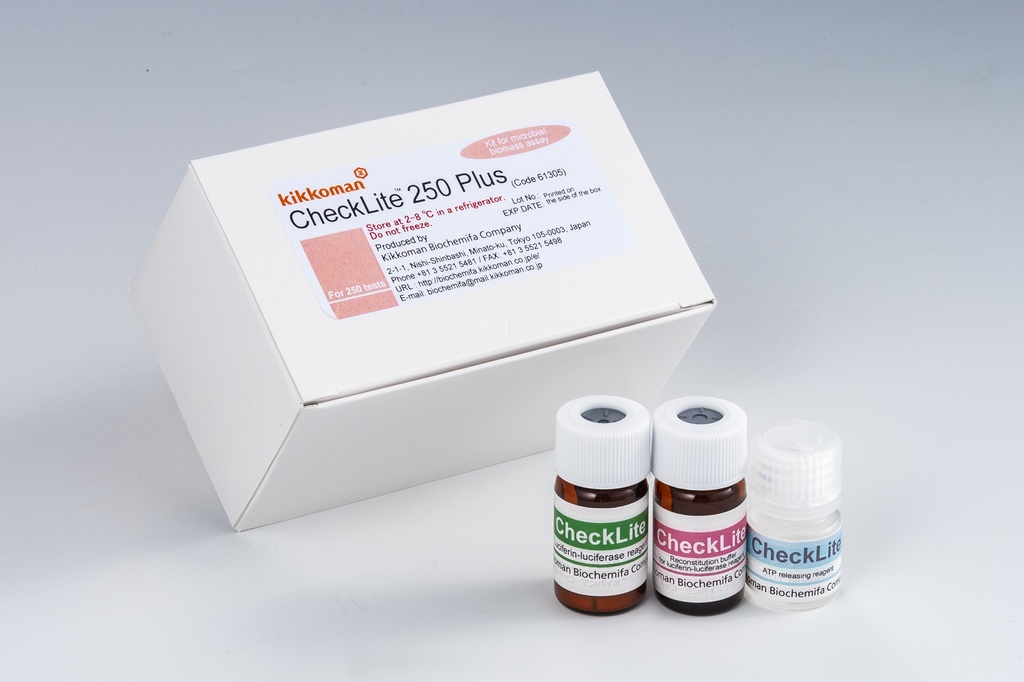Checklite 250 Plus
- Rapid detection of ATP from biomass including microbial cells
- Easy to use
| Verpackungsgröße: 1 Stk. |
CheckLite 250 Plus is a kit for microbial biomass assay and hygiene monitoring based on the ATP measuring method. It can detect the amount of ATP that is equal to over 10,000 cells of E. coli/ml.
It contains thermostable firefly luciferase. The bioluminescence reagent contains firefly luciferin and luciferase. This Luciferase enzyme catalyses the reaction where luminescence is observed due to ATP and luciferin’s interaction. The amount of bioluminescence produced in the reaction is directly proportional to the amount of ATP in the sample
1 x 250 determinations
Test duration: 20-40 minutes including calibration curve
Storage: 2 - 8 °C, DO NOT FREEZE
Contents of the kit:
Luciferin-Luciferase Reagent – 5 vials of lyophilized powder
Reconstitution Buffer - 5 vials (5.5 ml)
ATP Release Reagent - 5 vials (5.5 ml)
Preparation of the Bioluminescence Reagent
The Luciferin-Luciferase reagent is stored under vacuum in vials marked with green labels.
Pour the reconstitution buffer from the pink-labeled vial into the opened green-labeled vial and let it sit at room temperature for a few minutes (a slight sediment may form in the reconstitution buffer during storage. This does not affect the test results).
Gently stir the vial until the contents are completely dissolved. Avoid foam formation.
Do not touch the rim of the vial or the top of the rubber stopper directly with your hands, as this can sometimes increase the baseline value of the reagent.
One vial of Luciferin-Luciferase reagent can be used for more than 50 assays under normal conditions.
Handling of Samples
The ATP concentration in living cells changes rapidly. Therefore, extract ATP from the cells or freeze the cells immediately after sampling. Even in the case of extraction, it may be necessary to inhibit or destroy ATP-degrading enzymes to prevent enzymes from reducing the ATP concentration.
Pretreatment of Samples
Solid Samples:
Treat the sample with a stomacher or a homogenizer and use the supernatant for the subsequent measurement.
Liquid Samples:
If the sample solution is cloudy or colored, or contains inhibitory ions such as Cl-, dilute the sample as needed.
Measurement
Pour 100 µl of the sample, treated as described above, into a sample tube for measurement and add 100 µl of the ATP-releasing reagent solution into the sample tube.
Let the sample tube stand at room temperature for 10-60 seconds to extract ATP from the cells. The time required for extraction varies depending on the type of microorganisms. For example, it takes 10-20 seconds to extract ATP from bacterial cells and 60 seconds for yeast cells.
Immediately after extraction, add 100 µl of the Luciferin-Luciferase reagent solution and measure the amount of bioluminescence with a luminometer such as the Lumitester C-110 (ID No. 1 002 647).
To create a calibration curve, measure the amount of bioluminescence of stepwise dilutions of the ATP standard solution using the method described above.
The number of microbial cells (Colony Forming Units, CFU) can be determined based on the correlation between the amount of ATP and the number of CFU, which were previously counted using the conventional colony counting method.
